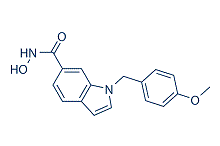| Description: |
PCI-34051 is a potent and selective HDAC8 inhibitor with IC50 of 10 nM, with >200-fold selectivity over the other HDAC isoforms. |
| Target: |
HDAC8:10 nM (IC50)
HDAC6:2.9 μM (IC50)
HDAC1:4 μM (IC50)
HDAC10:13 μM (IC50) |
| In Vivo: |
Administration of PCI-34051 and Dexamethasone reduces the eosinophilic inflammation and airway hyperresponsiveness in asthma to reduce the airway remodeling[2]. |
| In Vitro: |
PCI-34051 inhibits pure recombinant HDAC8 with Ki of 10 nM with >200-fold selectivity over the other HDACs tested, including HDACs 1, 2, 3, 6 and 10. PCI-34051 is derived from a low molecular weight hydroxamic acid scaffold that possessed promising potency (HDAC8; Ki=2 μM) and selectivity (approximately fivefold) for HDAC8 relative to the other class I HDACs. PCI-34051 is found to induce apoptosis at low micromolar concentrations in cell lines derived from T-cell lymphomas, including Jurkat and HuT78, whereas doses as high as 20 μM has no effect on B-cell- or myeloid-derived lymphomas or solid tumor lines[1]. |
| Kinase Assay: |
Histone deacetylase activity is measured using a continuous trypsin-coupled assay. For inhibitor characterization, measurements are performed in a reaction volume of 100 μL-1 using 96-well assay plates in a fluorescence plate reader. For each isozyme, the HDAC protein in reaction buffer (50 mM HEPES, 100 mM KCl, 0.001% Tween-20, 5% DMSO, pH 7.4, supplemented with bovine serum albumin at concentrations of 0-0.05% ) is mixed with inhibitor at various concentrations and allowed to incubate for 15 min. Trypsin is added to a final concentration of 50 nM, and acetyl-Gly-Ala-(N-acetyl-Lys)-amino-4-methylcoumarin is added to a final concentration of 25-100 μM to initiate the reaction. After a 30 min lag time, the fluorescence is measured over a 30 min time frame using an excitation wavelength of 355 nm and a detection wavelength of 460 nm. The increase in fluorescence with time is used as the measure of the reaction rate. Inhibition constants Ki(app) are obtained using the program BatchKi[1]. |
| Cell Assay: |
Tumor cell lines and human umbilical vein endothelial cells are cultured for at least two doubling times, and growth is monitored at the end of compound exposure using an Alamar Blue fluorometric cell proliferation assay as recommended by the manufacturer. Compounds (e.g.,PCI-34051) are assayed in triplicate wells in 96-well plates. The concentration required to inhibit cell growth by 50% (GI50) and 95% confidence intervals are estimated from nonlinear regression using a four-parameter logistic equation[1]. |
| Animal Administration: |
Mice[2] A mouse model of asthma is utilized. Briefly, healthy female BALB/C mice (n=72) aged 6-8 weeks and weighing 18-22 g are used. Animals are housed independently in a pathogen-free room and provided ad libitum access to water and standard food. Animals are housed for 1 week prior to experiment onset. Mice are divided into six treatment groups: normal control, simple asthma, Dexamethasone, Tubastatin A HCl, PCI-34051, and Givinostat. Sensitization is carried out for mice in the last five groups on the 1st, 8th and 15th day using ovalbumin (OVA, 20 μg) and aluminum hydroxide gel (2 mg). 7 days after the last sensitization, OVA (20 mg/mL) atomization is performed using an ultrasonic atomizing device (3 mL/min for 30 min, 3 times/week for 8 weeks). Dexamethasone (2.0 mg/kg), TSA (0.5 mg/kg), PCI-34051 (0.5 mg/kg) and Givinostat (0.5 mg/kg) are administered via intraperitoneal injection 30 min before excitation. In the normal control group, normal saline is used instead of OVA. |
| References: |
[1]. Balasubramanian S, et al. A novel histone deacetylase 8 (HDAC8)-specific inhibitor PCI-34051 induces apoptosis in T-cell lymphomas. Leukemia. 2008 May;22(5):1026-34.
[2]. Ren Y, et al. Therapeutic effects of histone deacetylase inhibitors in a murine asthma model. Inflamm Res. 2016 Dec;65(12):995-1008. |






















